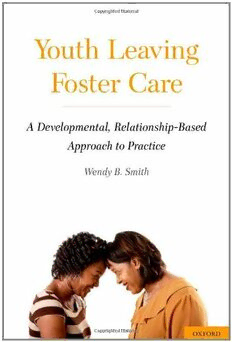
Youth Leaving Foster Care: A Developmental, Relationship-Based Approach to Practice PDF
Preview Youth Leaving Foster Care: A Developmental, Relationship-Based Approach to Practice
Youth Leaving Foster Care This page intentionally left blank YOUTH LEAVING FOSTER CARE A Developmental, Relationship-Based Approach to Practice Wendy B. Smith 1 1 Oxford University Press, Inc., publishes works that further Oxford University’s objective of excellence in research, scholarship, and education. Oxford New York Auckland Cape Town Dar es Salaam Hong Kong Karachi Kuala Lumpur Madrid Melbourne Mexico City Nairobi New Delhi Shanghai Taipei Toronto With offi ces in Argentina Austria Brazil Chile Czech Republic France Greece Guatemala Hungary Italy Japan Poland Portugal Singapore South Korea Switzerland Thailand Turkey Ukraine Vietnam Copyright © 2011 by Oxford University Press, Inc. Published by Oxford University Press, Inc. 198 Madison Avenue, New York, New York 10016 www.oup.com Oxford is a registered trademark of Oxford University Press All rights reserved. No part of this publication may be reproduced, stored in a retrieval system, or transmitted, in any form or by any means, electronic, mechanical, photocopying, recording, or otherwise, without the prior permission of Oxford University Press. ____________________________________________ Smith, Wendy Benjamin, 1946- Youth leaving foster care : a developmental, relationship-based approach to practice / Wendy B. Smith. p. cm. Includes bibliographical references and index. ISBN 978-0-19-537559-6 (hardcover : alk. paper) 1. Foster children–Services for–United States. 2. Foster children—Psychology. 3. Foster children–Counseling of. 4. Foster children–Family relationships—United States. 5. Foster children—Deinstitutionalization—United States. 6. Ex-foster children—Social conditions--United States . 7. Ex-foster children—Education—United States. 8. Foster children—Government policy—United States. I. Title. HV881.S66 2011 362.73’3—dc22 2010049034 ____________________________________________ 1 3 5 7 9 8 6 4 2 Printed in the United States of America on acid-free paper For all children who have been in foster care This page intentionally left blank ACKNOWLEDGMENTS T he idea for this book took shape some years ago, when I developed a course on youth leaving foster care, and could not fi nd a text on the sub- ject. I had treated alumni of foster care in my psychotherapy practice, had helped to design a transitional living program informed by attachment theory, and had long been active in a nonprofi t organization that assistsy- outh who have been in care. Most of what I had read focused on a single perspective—policy, program, outcomes, or youth narratives—and theo- retical frameworks were largely absent. My goal in writing this book was to integrate these interpenetrating, overlapping elements and to ground them in theory. I was fortunate to have my idea met with enthusiasm by many individuals, including Maura Roessner of Oxford University Press. There are many people to thank for their contributions to this book. First, the young people who generously shared their time and their stories with me—many youth from California Youth Connection, and at greater length, “Robert,” “Marie,” “Ericka,” “Summer,” and “Jessica”—who pro- vide the living heart of this book. I would like to thank the students and faculty at the University of Southern California School of Social Work, whose questions and interest spurred me on. Faculty members who deserve special thanks for their encouragement are Michalle MorBarak, Ron Astor, Dorian Traube, Devon Brooks, Jacquelyn McCroskey, Dean Marilyn Flynn, and Vice Dean Paul Maiden. I am grateful to Catherine Portuges, whose insight and keen edi- torial eye greatly improved the book proposal, as did the responses of reviewers. Thanks to Elizabeth Calvin and Carol Biondi, who provided invaluable comments on the juvenile justice system; to Adam Boltuch, vii viii ACKNOWLEDGMENTS for the design and creation of the Foster Care Timeline; and to Karl Calhoun for his interest and questions. Thanks also to Priscilla Roth, Judith Schore, Laura Parsons, and Elizabeth Forer, who offered helpful comments on early chapters. Jacqueline Mondros’s wholehearted support has been a sustaining presence. The insight and challenging questions of fellow members of the Center for the Study of Intersubjectivity contrib- uted to the fi nal version of the book. M any dear friends, my sister Roberta, and our parents, Alfred and Selma Benjamin, cheered me on throughout. A very special thank you is due to Catherine Conner, whose assistance has been a critical factor, fi rst in putting the original course together, and then with research and manuscript preparation for the book. I am so grateful for her effi cient, knowledgeable management of the logistics of this project, and for her serene intelligence. I want to thank my extraordinarily patient children and grandchildren: Rebecca, Alex, Jake, Matt, Erica, Elizabeth, Jesse, Aniela, Henry, Nate, and Marlowe. The time taken from them has been substantial and their sup- port unwavering. My deepest gratitude goes to my husband, Barry. Without his complete and unstinting belief in me, I’m not sure I could have written this book. —Wendy Smith CONTENTS Introduction xi Part I Setting the Stage Introduction to Part I 3 1. The Child Welfare System as Context 5 2. Theoretical Perspectives 20 Part II Development Introduction to Part II 35 3. Neurobiology and Development 37 4. The Importance of Early Attachments 52 5. Adolescent Development in Foster Care 68 Part III Mental Health Introduction to Part III 85 6. Anxiety, Trauma, and Post-Traumatic Stress Disorders 93 7. Mood Disorders and Self-Harm 108 8. Substance Abuse 125 9. Mental Health Dimensions of Delinquency 146 Part IV Program Considerations Introduction to Part IV 169 10. Populations Needing Special Attention 171 ix
